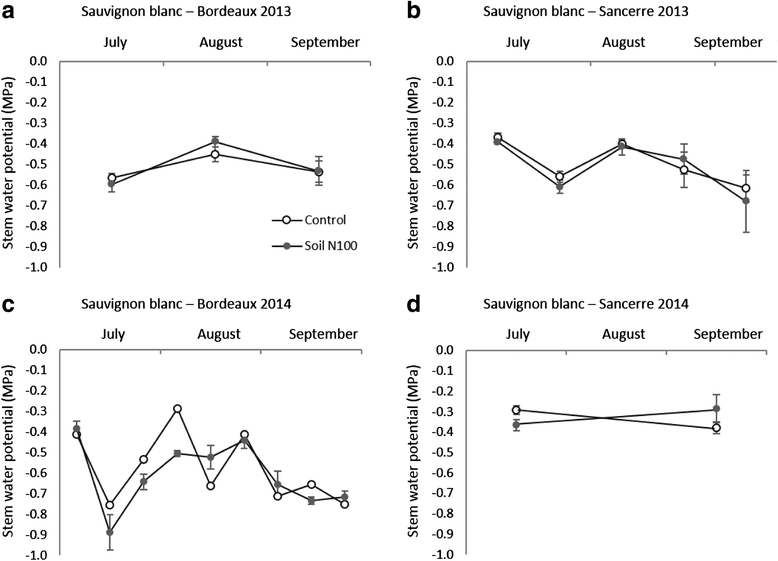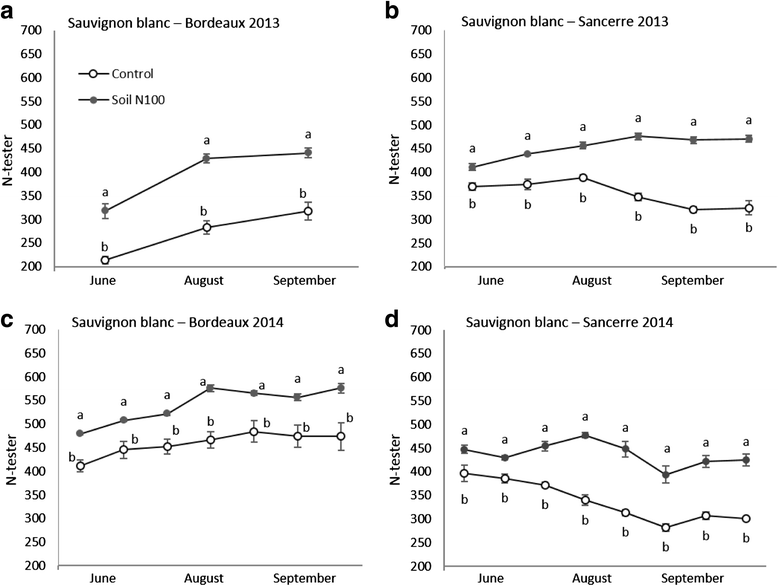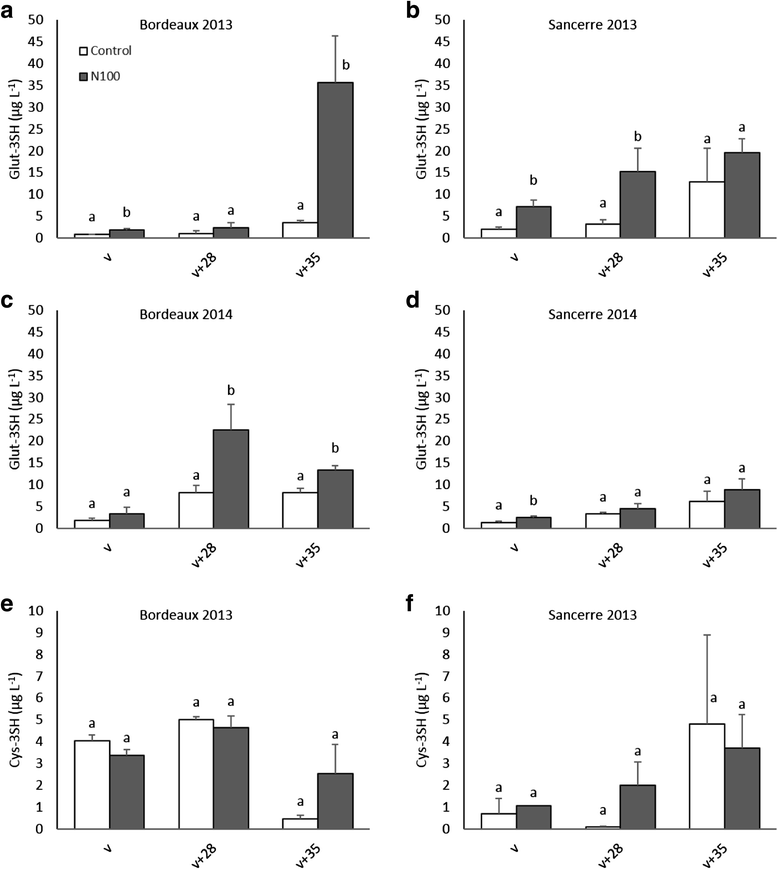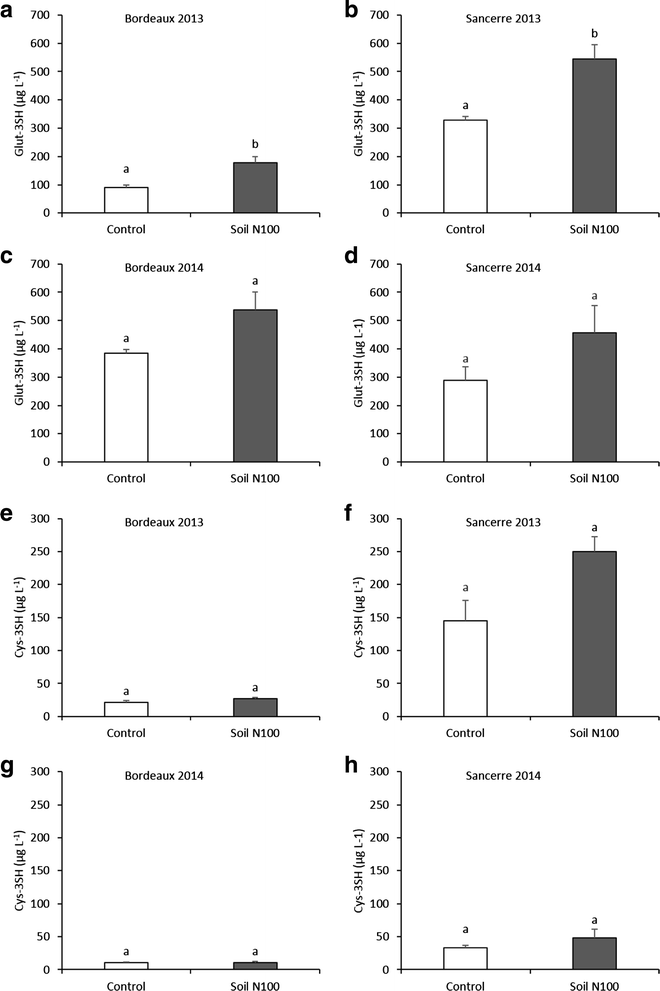Vine nitrogen status and volatile thiols and their precursors from plot to transcriptome level
- PMID: 27498539
- PMCID: PMC4976470
- DOI: 10.1186/s12870-016-0836-y
Vine nitrogen status and volatile thiols and their precursors from plot to transcriptome level
Abstract
Background: Volatile thiols largely contribute to the organoleptic characteristics and typicity of Sauvignon blanc wines. Among this family of odorous compounds, 3-sulfanylhexan-1-ol (3SH) and 4-methyl-4-sulfanylpentan-2-one (4MSP) have a major impact on wine flavor. These thiols are formed during alcoholic fermentation by the yeast from odorless, non-volatile precursors found in the berries and the must. The present study investigates the effects of vine nitrogen (N) status on 3SH and 4MSP content in Sauvignon blanc wine and on the glutathionylated and cysteinylated precursors of 3SH (Glut-3SH and Cys-3SH) in the berries and the must. This is paralleled by a RNA-seq analysis of gene expression in the berries. The impact of N supply on the expression of the glutathione-S-transferase 3 and 4 (VviGST3 and VviGST4) and the γ-glutamyltranspeptidase (VviGGT), considered as key genes in their biosynthesis, was also evaluated.
Results: N supply (N100 treatment) increased the 3SH content in wine while no effect was noticed on 4MSP level. Furthermore, N supply increased Glut-3SH levels in grape berries at late berry ripening stages, and this effect was highly significant in must at harvest. No significant effect of N addition was noticed on Cys-3SH concentration. The transcript abundance of the glutathione-S-transferases VviGST3 and VviGST4 and the γ-glutamyltranspeptidase (VviGGT), were similar between the control and the N100 treatment. New candidate genes which might be implicated in the biosynthetic pathway of 3SH precursors were identified by whole transcriptome shotgun sequencing (RNA-seq).
Conclusions: High vine N status has a positive effect on 3SH content in wine through an increase of Glut-3SH levels in grape berries and must. Candidate GSTs and glutathione-S-conjugates type transporters involved in this stimulation were identified by RNA-seq analysis.
Keywords: 3-sulfanylhexan-1-ol; 4-methyl-4-sulfanylpentan-2-one; Cysteinylated precursors; GGT; GST; Glutathionylated precursors; Nitrogen; Vitis vinifera; Volatile thiols.
Figures









References
-
- Ferreira V. Managing wine quality. 2010. Volatile aroma compounds and wine sensory attributes; pp. 3–28.
-
- Coetzee C, Brand J, Emerton G, Jacobson D, Silva Ferreira AC, du Toit WJ. Sensory interaction between 3-mercaptohexan-1-ol, 3-isobutyl-2-methoxypyrazine and oxidation-related compounds. Aust J Grape Wine Res. 2015;21:179–188. doi: 10.1111/ajgw.12133. - DOI
-
- Ribéreau-Gayon P, Glories Y, Maujean A, Dubourdieu D. Handbook of enology: the chemistry of wine stabilization and treatments. 2. 2006. Varietal aroma; pp. 205–230.
-
- Peyrot des Gachons C, van Leeuwen C, Tominaga T, Soyer JP, Gaudillère JP, Dubourdieu D. Influence of water and nitrogen deficit on fruit ripening and aroma potential of Vitis vinifera L. cv. Sauvignon blanc in field conditions. J Sci Food Agric. 2005;85:73–85. doi: 10.1002/jsfa.1919. - DOI
-
- Bayonove C, Cordonnier R, Dubois P. Study of an aromatic characteristic fraction of cabernet-sauvignon grape variety, identification of 2-methoxy-3-isobutyl-pyrazine. Comptes rendus Hebd des séances l’académie des Sci série D. 1975;281:75–78.
MeSH terms
Substances
LinkOut - more resources
Full Text Sources
Other Literature Sources
Molecular Biology Databases
Research Materials
Miscellaneous

